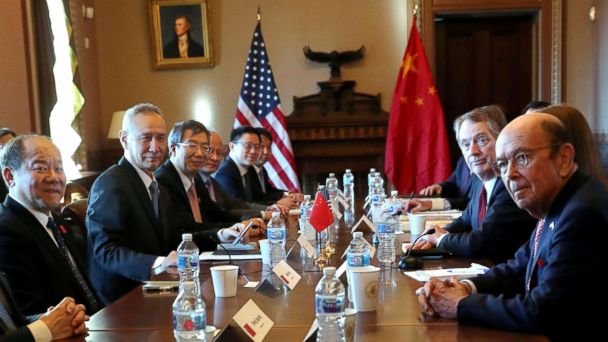Fentanyl Crisis: A Lever In U.S.-China Trade Negotiations?

Table of Contents
The Flow of Fentanyl from China
The connection between China and the U.S. fentanyl crisis is undeniable. China's role is multifaceted, encompassing the supply of precursor chemicals, the manufacturing process itself, and the challenges in effective distribution interdiction.
Precursor Chemicals: The Foundation of the Problem
China's role in supplying precursor chemicals is a critical element of the fentanyl crisis. These chemicals, the building blocks of fentanyl and its analogues, are often exported legally, but their subsequent diversion into illicit fentanyl production poses a significant challenge.
- Examples of precursor chemicals: Aniline, N-phenethylpiperidine, and various other chemical compounds.
- Lax export controls: While some controls exist, loopholes and inadequate enforcement allow significant quantities of these precursors to reach illicit markets.
- Difficulties in tracing the chemicals' journey: Tracking the flow of these chemicals from Chinese factories to clandestine labs is incredibly difficult, hindering effective law enforcement.
Statistics from the Drug Enforcement Administration (DEA) highlight the massive quantities of precursor chemicals exported from China annually, illustrating the scale of the problem. The lack of stringent tracking and verification mechanisms within international regulations further exacerbates this challenge.
Manufacturing and Distribution: A Complex Web
While not directly manufacturing fentanyl in all cases, China's involvement extends to the manufacturing and distribution processes. Chinese entities, both directly and indirectly, facilitate the production and shipment of fentanyl and its analogues.
- Methods of transportation: Smuggling routes are diverse, utilizing shipping containers, postal services, and even e-commerce platforms to move fentanyl precursors and finished products.
- Involvement of transnational criminal organizations: Complex networks of criminal organizations span multiple countries, leveraging China's chemical production and distribution capabilities.
- Challenges in intercepting shipments: The sheer volume of trade and the sophistication of smuggling techniques make it extremely difficult for law enforcement agencies to intercept all fentanyl shipments.
Numerous seizures of fentanyl and its precursors originating from or passing through China provide concrete evidence of this involvement. Investigations often reveal links between Chinese companies and these criminal networks, highlighting the need for greater accountability. The use of e-commerce platforms to facilitate the sale of precursor chemicals further complicates the situation.
Lack of Transparency and Accountability: A Major Hurdle
The lack of transparency from Chinese authorities regarding their role in the fentanyl crisis significantly hampers efforts to combat it. Holding those responsible accountable is equally challenging.
- Lack of cooperation from Chinese authorities: Limited cooperation in investigations and information sharing hinders efforts to dismantle criminal organizations and disrupt the supply chain.
- Difficulty in prosecuting cases: The transnational nature of the fentanyl trade makes it difficult to build strong cases for prosecution, especially when dealing with Chinese entities.
- Political sensitivities involved: The sensitive nature of U.S.-China relations often complicates efforts to address the fentanyl crisis directly and assertively.
Numerous failed diplomatic initiatives and criticisms of China's inadequate response to international pressure highlight the need for greater transparency and cooperation. The political sensitivities involved require a nuanced approach, balancing the need to address the crisis with the maintenance of productive diplomatic relations.
Using the Fentanyl Crisis as a Trade Negotiation Lever
The sheer scale of the fentanyl crisis and China's role in it create a powerful argument for leveraging this issue in trade negotiations. However, this requires careful strategy and consideration of potential consequences.
Potential Strategies: A Multi-pronged Approach
Several strategies could be employed to pressure China to curb fentanyl production and trafficking.
- Targeted sanctions: Imposing sanctions on specific Chinese entities involved in the fentanyl trade could disrupt supply chains.
- Trade restrictions: Restricting trade in specific goods or sectors could incentivize China to cooperate.
- Increased cooperation on law enforcement: Enhanced information sharing and joint investigations could lead to more effective enforcement.
- Incentives for cooperation: Offering incentives for cooperation, such as trade benefits or diplomatic concessions, could motivate China to take action.
Examples from previous trade disputes demonstrate the potential effectiveness of such leverage, although each case presents unique complexities. The potential economic consequences for China must be carefully weighed against the humanitarian costs of the fentanyl crisis. Anticipating and mitigating potential political backlash from China is crucial.
Challenges and Obstacles: Navigating Complexities
Using the fentanyl crisis as a bargaining chip faces numerous challenges.
- China's economic leverage: China's significant economic power gives it leverage in trade negotiations, making it difficult to impose significant penalties.
- Concerns about escalating tensions: Aggressive tactics could exacerbate already strained U.S.-China relations.
- The complexity of the supply chain: The intricate and transnational nature of the fentanyl supply chain makes it difficult to target all actors effectively.
- Resistance to external pressure: China may resist external pressure to address internal issues, especially those impacting its sovereignty.
The potential for retaliatory measures from China must be anticipated and mitigated. The impact on other aspects of the U.S.-China relationship needs careful consideration. Overly aggressive tactics risk undermining broader diplomatic efforts to manage the relationship.
International Cooperation: A Necessary Component
Addressing the global fentanyl crisis effectively requires international collaboration.
- Sharing of intelligence: Pooling intelligence gathered by various countries can strengthen law enforcement efforts.
- Joint investigations: Collaborative investigations can facilitate the prosecution of transnational criminal organizations.
- Stronger international regulations: International agreements and regulations can better control precursor chemicals.
- Collaborative efforts to disrupt trafficking routes: Joint operations to disrupt trafficking routes can reduce the flow of fentanyl.
Examples of successful international cooperation initiatives demonstrate the potential benefits of collaborative efforts. Multilateral agreements can create a stronger framework for combating the global fentanyl crisis. However, coordinating international efforts and overcoming differences in national priorities can present significant challenges.
Conclusion
The fentanyl crisis presents a grave challenge requiring a comprehensive response. While leveraging it in U.S.-China trade negotiations offers a potential avenue, it's fraught with complexities and risks. Success depends on a multifaceted approach: targeted pressure, international cooperation, and addressing the underlying issues driving the fentanyl trade. Ignoring this potential lever would be a missed opportunity. The U.S. must pursue a strategic approach that balances curtailing the flow of fentanyl with broader U.S.-China relations and global stability. Addressing the fentanyl crisis effectively requires a comprehensive strategy that encompasses both trade negotiations and robust international collaboration. Only through concerted and sustained efforts can we hope to mitigate the devastating effects of this global health emergency.

Featured Posts
-
 What Did Franco Colapinto Say In His Deleted Drive To Survive Message
May 09, 2025
What Did Franco Colapinto Say In His Deleted Drive To Survive Message
May 09, 2025 -
 Dakota Johnsons Stunning White Dress At Materialists Premiere
May 09, 2025
Dakota Johnsons Stunning White Dress At Materialists Premiere
May 09, 2025 -
 The Daily Fox News Appearances Of The Us Attorney General Whats Really Going On
May 09, 2025
The Daily Fox News Appearances Of The Us Attorney General Whats Really Going On
May 09, 2025 -
 Edmonton Oilers Los Angeles Kings Series Your Guide To Betting Odds
May 09, 2025
Edmonton Oilers Los Angeles Kings Series Your Guide To Betting Odds
May 09, 2025 -
 Trumps Houthi Truce Will It Ease Shipping Concerns
May 09, 2025
Trumps Houthi Truce Will It Ease Shipping Concerns
May 09, 2025
